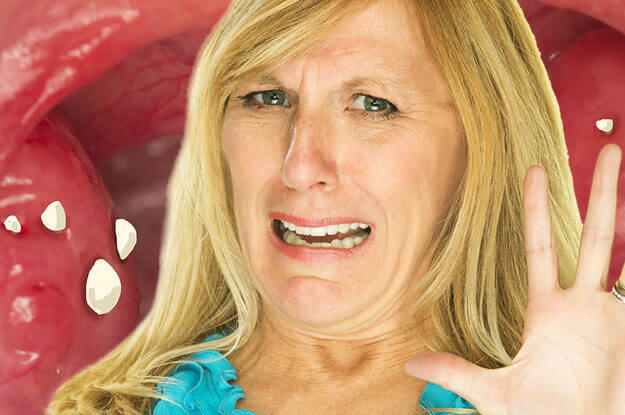Author: Lizzie Smith – blog last updated on Saturday 6th January 2024
Like gum disease or white deposits on your tongue, the cause of bad breath can also be in your tonsils. In all these cases, harmful oral bacteria play a role, and in this article, we’ll look at bad breath caused by tonsil stones. And, more importantly, what can you do to get your breath fresh again?
Tonsil stones
Tonsil stones are dirty white or light yellow lumps. They’re formed in the tonsils or crypts and can be very smelly.
The tonsils are part of the lymphatic system that, together with other tissues and organs, protect your throat and nasal cavity against incoming bacteria and viruses. The immune cells in the tonsils produce antibodies that tackle the pathogens, helping to prevent throat and lung infections or at least ensure they’re less severe.
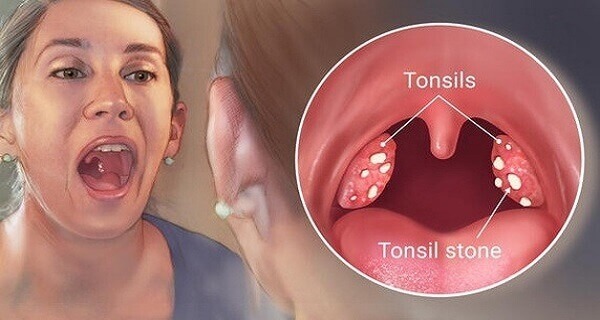
Lymphatic tissues are rough in texture, as are the tonsils. The lymphatic system expels food and mucous cells from the lymphatic system from the many grooves and openings. This tissue’s disadvantage is that it can get stuck in the tonsil crypts and clog them, especially when the tonsil tissue weakens due to ageing. Scar tissue from throat infections makes the tonsils‘ textures even messier, meaning bacteria and food residues can also accumulate.
Smelly stones
Although tonsil stones can also be soft lumps, they always smell. Despite good oral hygiene, you can still have bad breath and possibly a metallic taste in your mouth.

The stench and bad taste are caused by anaerobic bacteria, which occur in large numbers. They thrive in this enclosed, favourable environment full of waste and food. They secrete gases such as methanethiol, sulphur, hydrogen sulphide and ammonia, which you then exhale.
What can you do about tonsil stones and bad breath?
First, you can reduce the risk of tonsil stones as much as possible. But because factors that can’t be influenced also play a role, some people continue to suffer from them. If this is the case, you’ll have no choice but to remove them. Below, we’ll look at both instances.
Preventing or slowing down tonsil stones
1. Choose your oral products with care
Many regular toothpastes and mouthwashes contain aggressive ingredients that kill harmful bacteria but also disrupt the natural balance of the oral flora. You should avoid substances such as alcohol, chlorhexidine, triclosan, SLS (sodium lauryl sulphate) and chemical colours and flavours, especially if you want to get rid of bad breath and prevent or slow down the formation of tonsil stones.
Choose effective but mild products that respect the balance of your oral flora and stabilise the acidity of your saliva. These things are essential for clean teeth and healthy gums.
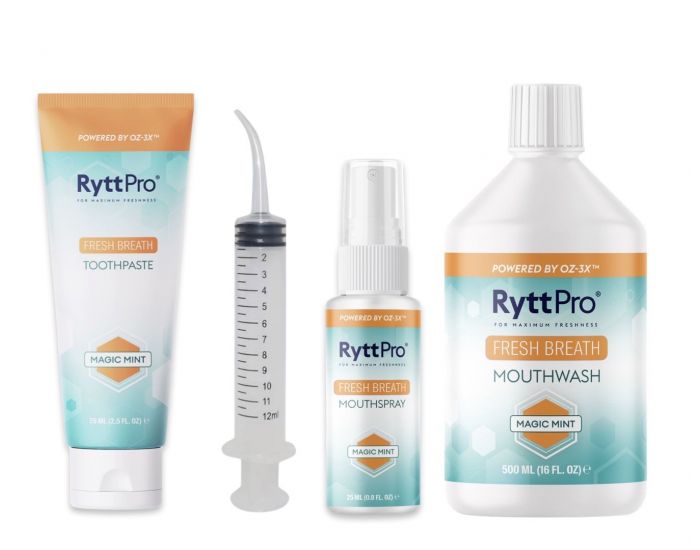
With the RyttPro Tonsil Stone Removal Kit, you can get started immediately. The complete package for fresh breath includes toothpaste, mouthwash, mouth spray and a tongue cleaner.
RyttPro Toothpaste Magic Mint is a mild toothpaste that fights harmful oral bacteria through the powerful formula OZ-3X – a unique, safe combination of stabilised chlorine dioxide, zinc and cetylpyridinium. The toothpaste contains fluoride and hydrated silicon to protect teeth against caries (cavities).
Clean your tongue with the RyttPro tongue cleaner, an effective combination of tongue scraper and tongue brush. Brush your tongue with the brush side and then wipe the deposits and dirt from your tongue.
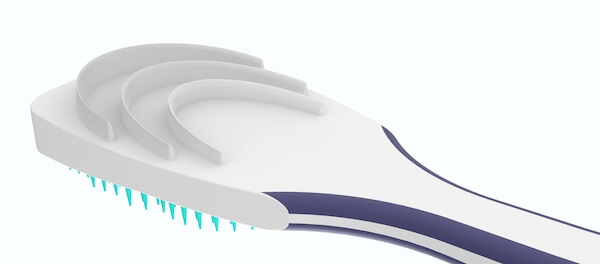
Then rinse your mouth with RyttPro Oral Rinse. The OZ-3X formula fights harmful bacteria but supports your oral flora and stabilises the acidity in your mouth.
During the day, freshen your breath and hydrate your oral mucosa with RyttPro Mouthspray. This product also uses the safe but effective OZ-3X formula.
All three RyttPro products have a mild mint flavour, immediately giving you fresh breath and a clean mouth.

Another mouth-friendly option is the JuliBrite Tongue Clean Kit, which contains toothpaste, mouthwash, a tongue cleaner and a unique tongue gel. JuliBrite products tackle harmful oral bacteria through active oxygen generated by honey. Together with zinc, this combats harmful bacteria effectively, but without disrupting the balance of the oral flora.
The formula also contains the natural enzyme hyaluronan. This anti-inflammatory agent works just as well as chlorhexidine but without the unpleasant side effects for the oral flora. Xylitol prevents the adhesion of bacteria to the tooth enamel and stimulates the salivary glands.
Clean your tongue with the JuliBrite tongue cleaner – an effective combination of tongue scraper and tongue brush. Brush your tongue with the brush side and a little JuliBrite Tongue gel. Let it work briefly, then wipe the gel deposit off your tongue.
2. Pay extra attention if you have a cold or flu
Although you may feel too ill to take good care of your teeth and throat, it’s essential to maintain at least your daily oral hygiene, but it’s better if you can do something extra.
The lymphatic tissues (including your tonsils if you still have them) work quickly during an infection. The tonsils themselves can often become inflamed. If your tonsils are red, swollen and covered with white deposits, this indicates a bacterial infection. However, it’s a viral infection if they only look red and swollen, without deposits.
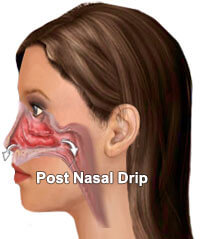
When you have flu, excess nasal mucus doesn’t make the throat and oral cavity any cleaner either. When irritated, the nasal mucous membranes secrete more mucus, causing the well-known runny nose. What isn’t drained through your nostrils disappears into your pharynx, and this natural reaction is called post-nasal drip.
You can make the post-nasal drip cleaner with good natural nasal drops. With the non-addictive TonsilFresh Nasal Sinus Drops, you ensure fewer bacteria travel to your throat.
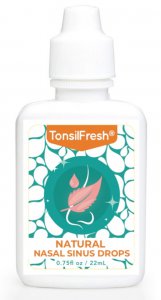
3. Intensive care for the tongue and tonsils
In the fight against tonsil stones, an extra intensive approach after cleaning your tongue won’t hurt. This can be easily done by sprinkling a few drops of Bergenfeld Tongue Serum on the back of your tongue. This serum combats harmful bacteria and their smelly gases intensively but leaves the natural balance of the oral flora undisturbed.
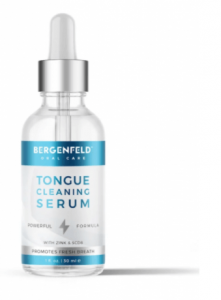
The same goes for Oral Icon Tonsil Serum. You can also use this at the back of your throat and on your tonsils. In addition to the safe formula of stabilised chlorine dioxide, zinc, cetylpyridinium chloride and salt, it contains caring ingredients. Aloe vera and glycerin moisturise and soften the soft tissues of your pharynx. The natural sweetener xylitol stabilises the acidity, and the fresh taste stimulates your salivary glands.
Removing tonsil stones
You can do everything you can to prevent them, but you may still suffer from tonsil stones. Some people are simply sensitive to them. This isn’t solely down to your oral hygiene but also genetic factors, the composition of your saliva and your diet, amongst other things.
Many people who regularly suffer from tonsil stones remove them with a moist cotton swab. This still works with superficial tonsil stones, but you’ll need better tools for the more deeply clogged ones.
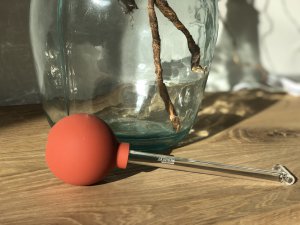
The TonsilClin Cupping Pipette is a simple but ingenious instrument. You can also remove the more deeply clogged, seemingly invisible tonsil stones. It consists of a glass pipette with a rubber suction ball. There, you squeeze out the air, placing the end of the pipette on your tonsils. As soon as you release the ball, a vacuum is created, which sucks tonsil stones and other debris from the grooves.
Finally
Removing tonsil stones from the tonsils yourself is possible, but only some are skilled at it. If your tonsils are clean, but you still have bad breath, tonsil stones may be in your tonsils. They’re so deep in the back of your throat that you can’t reach them.
If you have severe or chronically inflamed tonsils or other throat complaints, you should consult your doctor, who can refer you to an ENT specialist. This also applies if you’re unable to remove the tonsil stones yourself or if you can’t reach them.
Sources
British Dental Association: Improving oral health
British Dental Journal: Help your patients tackle bad breath

